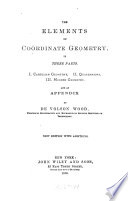 | De Volson Wood - 1890 - 372 pages
...mathematics ; and the invention of this system was made when he established the relation «' =j* = k' = - 1 ; ij = k, jk = i, ki =j ; ji= —k, kj= — i, ik — —j ; which he did in an article first published in 18434 Out of this grew his system of Quaternions. §... | |
 | Royal Society of Edinburgh - 1902 - 594 pages
...k. The rules rued by vector-analysts are : — i«=+l ^=+1 /,-2=+l y'= ^ fo~ * ','«== / ji=-k kj=-i ik= -j, and they suppose an order from left to right....preserved, while the products become associative? I find that the desired modification is accomplished by introducing ,J — 1 before the second and... | |
 | American Academy of Arts and Sciences - 1917 - 1060 pages
...simplicity by introducing vector multiplication. If we adopt the Hamiltonian laws for i, j, and k, — ij = k, jk = i, ki = j; ji = — k, kj = — i, ik = — j, {t = f = If = - 1. it is well known that vector multiplication is distributive with respect to addition... | |
 | Jagjit Singh - 1959 - 340 pages
...to interpret the result of this mathematical abracadabra? We overcome the difficulty by defining — IJ = K, JK = I, KI = J; JI = -K, KJ = -I, IK = -J. Our product then becomes: -(*x' + yy' + zzO + I(yz' - y'z) + J(zx' - z'x) + K(x/ - x». We can now... | |
 | Ian Stewart, David Orme Tall - 1977 - 280 pages
...His discovery can be explained in terms of three symbols i, j, k multiplied according to the rules: ij = k, jk = i, ki = j ji = -k, kj = -i, ik = -j. The last six of these can be described by writing the symbols i, j, k in a clockwise cycle and then... | |
 | Murray G. Murphey - 1993 - 454 pages
...study of those properties of an algebraic form which are preserved when the form is "Ibid., p. 28. 11 ij = k, jk = i, ki = j, ji = - k, kj = -i, ik = - j. MacDuffee, "Algebra's Debt to Hamilton," pp. 31-33 and Robert Perceval Graves, Life of Sir William... | |
 | Frank Swetz - 1995 - 322 pages
...units 1, i, j, k, ie, quaternions. Multiplication no longer obeys the commutative law. The rules are: ij = k, jk = i, ki = j, ji = -k, kj = -i, ik — -j, ii = jj = kk = -1 [6, pp. 29-30]. These quaternions have four dimensions, one real, the scalar part,... | |
 | John H. Conway, Richard Guy - 1998 - 338 pages
...three-dimensional vector v = bi + cj + dk. You add them in the obvious way, but multiply them using ij = k jk = i ki = j ji = -k kj = -i ik = -j For instance: Hamilton's rules. (2 + 0(3 + J) = 6 + 3i + 2j + k, (3 + JX2 + 0 = 6 + 3*+ 2J - k, but... | |
 | Reuben Hersh - 1997 - 372 pages
...to multiply i, j, k by each other. This was the hard part. Hamilton discovered the system worked if ij = k jk = i ki = j ji = -k kj = -i ik = -j The commutative law has vanished! Instead, an "anticommutative taw." This was the first time anyone... | |
 | Stephen J. Sangwine, Robin E.N. Horne - 1998 - 488 pages
...engineering). The properties of the three operators are as follows: i2 = / = k2 = ijk = -1 . (12.5) ij = k jk — i ki = j ji — —k kj = —i ik = —j Note that within the ring of quaternions, there are three complex sub-fields. A quaternion-space (which... | |
| |